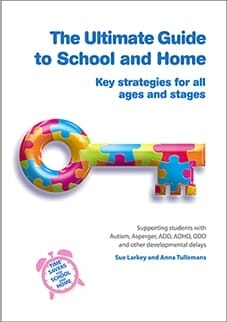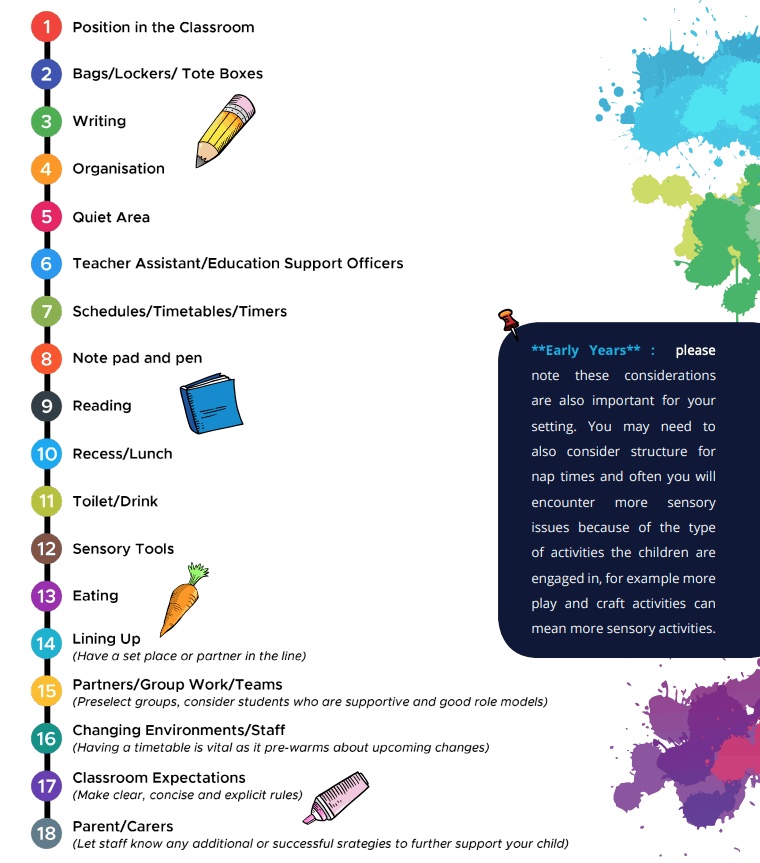13 KEY STRATEGIES TO SETTING
UP YOUR CLASSROOM
Strategies 1-7
1. Position in classroom
(Seating, mat time, assembly, parades)- have a set position for the student which takes into account:
- Who they are next to
- Where in the room or group
- How close they are to teacher
- Distractions
- Whether they are too close to favourite activities like books, computers, Lego etc.
- Sensory distractions (noises, smells, lighting, objects hanging too close).
- Some students prefer to be near a door so they can leave if anxiety is building (particularly in secondary).
2. BAGS/LOCKERS/TOTE BOXES
Ensure these students are at the quiet end of the row. Students often don’t like being touched, feeling crowded or the noise that happens in the busy areas.
3. Writing
60% of students with ASD have dysgraphia. Students often don’t like being touched, feeling crowded or the noise that happens in the busy areas. means handwriting can be messy, slow or sometimes even avoided, especially as they get older. You may need to consider allowing iPads, computers and other
forms of technology as their means of writing as the goal is that they do the work. In the younger years pencil grips can support handwriting skills.
(Grips available at
https://suelarkey.com.au/product/pencil-grip/)
This
4. ORGANISATION
ASD students often find organisation of their school equipment very difcult. Limit the number of books, and equipment, perhaps set up system like colour coding to help with organisation.
5. QUIET AREA
Ensure there is an area where the student can retreat to if they are feeling overwhelmed. This can be a quiet table, reading corner, outside the classroom in hallway, alcove, ofce, etc. Some students also need to be placed near a door in the classroom or assembly as they need a perceived escape route.
6. TEACHER ASSISTANT / EDUCATION SUPPORT OFFICERS
Consider how best to use support time effectively in the first few weeks. You may need them to make additional support materials, schedules, visuals, social stories, organisation etc. See Cardinal Rules for Assistants in Teacher Assistants Big Red Book of Ideas page 4. (available here)
7. SCHEDULES/TIMETABLES/TIMER
These are VITAL no matter what age. This may be in a range of formats such as photos, visuals or words. Using a Timer supports the schedule and allows students to know HOW LONG activities will take.
Strategies 8-13
8. NOTE PAD AND PEN
Always carry a note book and pen for when things change we tend to talk too much. These children are visual and if you can write it down or draw a picture it can stop behaviour escalating.
9. READING
Be aware many students have hyperlexia where they can decipher written words but do not comprehend what they are reading
10. RECESS/LUNCH
Make sure they know boundaries, days they are allowed on equipment, where to go if there’s a problem, safe places, when library is open, clubs they can join etc.
11. TOILET/DRINK
Many students with ASD will not access these at the same time as other students. It is recommended you send them out during class time to the toilet and get a drink as this can impact on their learning. BE AWARE they may not ask you to go to the toilet you will need to send them
(Great Podcast on this at: https://suelarkey.com.au/top-tips-for-toilet-training/)
12. SENSORY TOOLS
Many students require sensory tools to focus, process or calm. You will probably need to provide a range of sensory tools for the student. This may include a sensory mat to sit on, fidget tools, chewy necklaces, tubes or pencil toppers (see resources at: https://suelarkey.com.au/sensory-shop/)
13. EATING
Because of their sensory processing difculties some students fnd it hard to eat at appropriate times because the smells of other student’s food or even the sound of them eating many be overwhelming. You may need to allow them to eat separately from other students.
**Early Years**
Please note the above considerations are also important for your setting. You may need to also consider structure for nap times and often you will encounter more sensory issues because of the type of activities the children are engaged in, for example more play and craft activities can mean more sensory activities.
Excerpt from The Ultimate Guide to School and Home
by Sue Larkey and Anna Tullemans
The Ultimate Guide to School and Home
By Sue Larkey and Anna Tullemans

- Engaging Disengaged Students
- Making learning fun
- Teacher Assistants: Key strategies to support students
- What to do if you don’t have any help
- Adapting tasks and making adjustments
- The importance of downtime
Over 500 NW strategies and ideas!
This is a resource that every school, early childhood centre and home should have!!
18 ways to set up a classroom



 Sorry we no longer ship items outside Australia. Please consider the digital versions of Sue’s Books –
Sorry we no longer ship items outside Australia. Please consider the digital versions of Sue’s Books – 